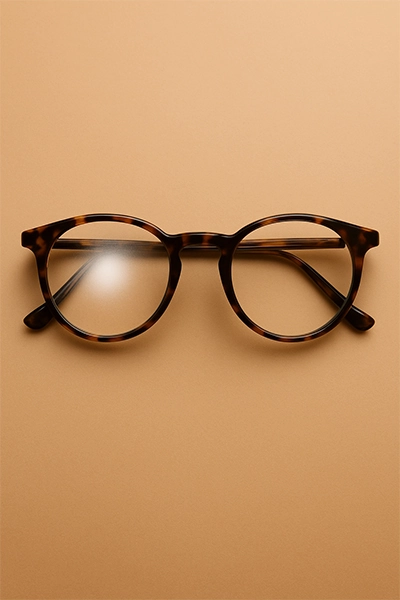
What are the frequently asked questions about lenses, filters, and treatments for glasses?
When purchasing prescription or sunglasses, the type of lens and the related treatments make a big difference in visual comfort and the longevity of the glasses. But what does “anti-reflective” mean? And what is the difference between polarized and photochromic? In this article, we clarify the most common doubts about lenses, filters, and treatments, helping you make a more informed choice.
Lenses: the basics to know before purchasing
Single vision or multifocal?
Single vision lenses correct one distance (far or near).
Progressive (multifocal) lenses cover multiple distances in one lens: far, intermediate, near.
👉 If you want to delve deeper, also read:
What to know about progressive and multifocal lenses
What is the difference between CR39, polycarbonate, and high index?
- CR39 → excellent optical quality, but heavier
- Polycarbonate → very light and impact-resistant
- High index → thinner, ideal for high prescriptions
Brands like Lindberg, Zeiss, or Gucci often use more technical and high-performance materials.
Useful treatments (and when they are really needed)
- 🟢 Anti-reflective
Eliminates annoying reflections, improves clarity and comfort, especially at the computer or while driving.
- 🟡 Scratch-resistant
Does not make the lenses "indestructible," but protects them from accidental scratches and extends their life.
Image: Damaged lens with scratches + perfect lens (did: “No more accidental scratches”) - 🔵 Hydrophobic / oleophobic
Makes the lens easier to clean, repels water, dust, and fingerprints. - 🟠 UV filter
Protects against ultraviolet rays. Essential even for clear lenses.
👉 Many models from Tom Ford, Lozza, Emporio Armani, Polaroid include these treatments as standard or optional.
Special filters: who needs them
Polarized lens
Blocks horizontal reflections (asphalt, water, snow). Great for:
- Those who drive often
- Those who work outdoors
- Those who engage in sports like sailing or fishing
📌 You can find polarized lenses in selected models from Persol, Carrera, Guess, Vuarnet, Polaroid.
Blue light filter
Protects from artificial light emitted by digital screens.
Ideal for those who work at the computer or frequently use smartphones.
Also available in neutral lenses on Vogue, Liu Jo, Hugo Boss, Ray-Ban models.
Photochromic lenses
Adapt to light: darken in the sun and lighten in indoor environments.
Perfect for those who are often on the move and want one lens for both indoor and outdoor.
You can find them, for example, on frames from Marc Jacobs, Prada Linea Rossa, Michael Kors, or L.G.R.
Common mistakes to avoid when choosing lenses
- Buying without an updated prescription
- Using the wrong treatments for everyday use
- Ignoring the type of frame: thick lenses on light glasses = discomfort
- Buying online without optical assistance
- Thinking that all treatments are the same (they are not)
👉 Also read: Guide to safely purchasing glasses online
Practical examples for choosing the right treatment
- Office / computer all day?
→ Single vision + anti-reflective + blue light filter - High myopia and stylish frame?
→ High index lens + anti-reflective + scratch-resistant - Outdoor and driving?
→ Polarized + photochromic (even prescription) - Sports or heavy use?
→ Polycarbonate + scratch-resistant + UV filter
FAQ – Frequently Asked Questions
❓ Are polarized lenses also good for everyday use?
Yes, they improve contrast and vision even in the city, not just at the beach.
❓ Is the blue light filter always necessary?
It is recommended if you spend more than 3 hours a day in front of digital screens.
❓ Is the anti-reflective treatment mandatory?
No, but it is highly recommended for those who drive, study, or work on the computer.
❓ Do photochromic lenses activate automatically?
Only some models optimized to work behind the windshield. Ask your trusted optician.